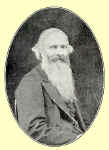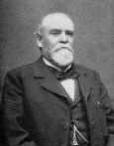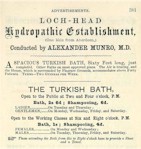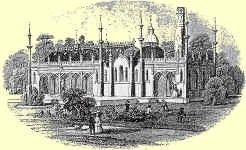Alexander Munro
 In 1851, the Reverend Alexander Munro bought the mansion and grounds at Lochhead, about a mile to the north-east of Aberdeen, and opened a hydropathic establishment there. At the same time, he was also Congregational minister of the small chapel at Skene, some six miles away. He was widely known as Dr Munro though his qualification came, in fact, from a hydropathic college in the United States. Although previously he had successfully completed the required course for medical students at the University of Aberdeen, he was not allowed to graduate as he was already practising as a hydropathist.
In 1851, the Reverend Alexander Munro bought the mansion and grounds at Lochhead, about a mile to the north-east of Aberdeen, and opened a hydropathic establishment there. At the same time, he was also Congregational minister of the small chapel at Skene, some six miles away. He was widely known as Dr Munro though his qualification came, in fact, from a hydropathic college in the United States. Although previously he had successfully completed the required course for medical students at the University of Aberdeen, he was not allowed to graduate as he was already practising as a hydropathist.
Lochhead started in a small way with fairly primitive facilities. Showers were taken in a small hut near the house and 'the stronger patients were expected to pump the water from a stream near by to a tank on the roof '.1
But the facilities were gradually improved and in 1857 Munro sold the establishment to a new partner, Dr William Meikle, while continuing to 'conduct' its daily running as superintendent. Meikle died the following year but in 1861 his executors sold the hydro to a younger brother, Dr Thomas Henry Meikle, then aged only 27 years old. He retained it for seven years, while Munro himself left round about 1863.

It is possible that when T H Meikle first built the Turkish baths at Lochhead he intended them to be run as a separate (albeit related) establishment; some of the first advertisements for the Turkish bath made no mention of treatments available at the hydro and Munro's name was omitted.2 After a few months, however, a new set of advertisements showed more clearly that they were part of the hydro, and Munro's name re-appeared. The hydropathic establishment clearly benefitted from the addition of the Turkish bath which aimed to be 'a model of comfort and elegance'. Furthermore, as a result of further investment by the Meikle brothers, the house could now accommodate forty patients at two guineas per week.3
The Turkish baths
The new Turkish baths were designed by the architect, Mr William Hardie Hay, and Munro's unorthodox medical qualification did not stop the well-known physician and classical scholar, Francis Adams, from visiting them and describing them as 'elegant'.4
Patients at Lochhead used the Turkish baths in the mornings and then they were opened at two and four o'clock each day to the general public, though not of course, given Munro's other calling, on Sundays.

The standard charge was 2s.6d. and the baths were reserved for women on Tuesday and Thursday afternoons. They were also available for two hours in the evening 'For the Working Classes (who require to provide themselves with a Sheet and Towel)' at the lower charge of one shilling, with two evenings again being reserved for women. Shampooing was also available at 6d and, for the working classes, at 3d,5 though after a couple of months this latter charge was raised to 4d.6

Externally, the Turkish baths were built in oriental style although Hay himself would have preferred a more 'thoroughly English' approach. He was able to follow this preference only in the interior of the building because, as he explained to members of the Liverpool Architectural Society, he was employed to build Turkish baths and Turkish baths they had to be. In practical terms this meant that so as not to disappoint the expectations of the uninitiated, 'the bulbous domes and gilded minarets must appear in all the cheapest and most showy style, so that the Oriental character might be realised as freshly as from a perusal of
Lalla Rookh.'7
The internal design
Leading off the 18 foot square entrance hall, lit through pieces of coloured glass set in a dome, were small alcoves for undressing, screened off with curtains and furnished with seats and couches. The cooling-room, also furnished with couches, was the same size as the entrance hall, but without a dome. The two hot rooms, kept at 100°F and 150°F, were fitted with seats and shampooing tables. In the last room, together with a variety of douches, there was a needle shower, 'a niche provided and completely surrounded with a coil of pipe, perforated and made to play upon the bather like a horizontal shower of rain.'
According to Hay, the baths 'give great satisfaction, and yield a large and lucrative percentage.'

Dr Alastair Durie
Senior Lecturer, Dept of Economic & Social History,
Glasgow University
Michelle Gait, Special Libraries and Archives, University of Aberdeen




